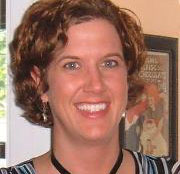Learn to Write for Children: Tips from Margo L. Dill
 I've never tried writing for children's publications but I've always been intrigued by the idea. It must be so rewarding to reach out and entertain a child through your writing. I still remember all the articles and stories I read in magazines, such as Cricket, as a child. Maybe it's because I was so young that the stories stuck with me, or the fact that I was reading something I wanted to read for the first time.
I've never tried writing for children's publications but I've always been intrigued by the idea. It must be so rewarding to reach out and entertain a child through your writing. I still remember all the articles and stories I read in magazines, such as Cricket, as a child. Maybe it's because I was so young that the stories stuck with me, or the fact that I was reading something I wanted to read for the first time.So to gain a bit of insight into this market, I caught up with Margo L. Dill and asked her a few questions on the subject. Margo teaches the e-course Writing for Children. The course begins next Wednesday, January 13th. If this is a market you've been thinking about writing for, I urge you to visit the classroom page and sign up today.
Welcome, Margo! Like I mentioned above, I'm new to children's writing. So tell me, what are the different types of manuscripts children's magazines accept?
Margo: Children's magazines accept short stories, poems, and articles. They also accept fillers, which are pieces like recipes, puzzles, quizzes, and arts and crafts.
That's a wide variety, and it sounds like a lot of fun. If a writer wanted to craft a short story for a children's magazine, what things should she keep in mind to better target her market?
Margo: I teach about the characteristics of a children's short story during the fiction lessons because writing a short story for children is very different than writing for adults. The age of the main character is very important and should be the same age or older than the target age range. For example, if you are writing a short story for readers between 8 and 12 years old, the main character should be 11 or 12. As a rule, children don't like to read about kids younger than them or adults as main characters. The other big mistake I see made in many children's stories, and we cover this in the class, is that the child protagonist does not solve his own problem. An adult swoops in and saves the day. Children want to read about other children solving their own problems.
I never thought about it, but that makes complete sense. I think it's a good lesson too for children to learn how to solve their own problems. In your class curriculum you recommend sending a cover letter with a short story submission. Are cover letters important? Shouldn't the story stand on its own?
Margo: Writing for children is a business. If you want a magazine editor to take you seriously, then you need to learn the business. On cold submissions, magazine editors expect to see a cover letter with your submission--this includes e-mail and snail mail submissions. The cover letter should be short and simple, just like you were sending a cover letter with a job application. The job application speaks for itself, but the cover letter highlights some important points. Same is true for a short story cover letter. It should briefly explain the story, tell the word count, why the story fits in the magazine, and a few of your credentials. That's it!
Great advice, and it sounds simple enough. Let's talk nonfiction articles. You mention that it's easier to break into the children's magazine market with nonfiction. That's also true with the adult magazine market. In your opinion, how do these markets differ?
Margo: The biggest difference is that there are fewer nonfiction children's magazines than there are adult magazines, so the competition is fierce. Therefore, you have to know how to research your market and your topic to give yourself an advantage over other freelance writers. You also must write a killer query letter, which we work on in the online class. Many children's magazines have theme lists; so before you send your query, it is important to see if your idea will fit in any of the themes. Some magazines will invite queries that do not fit in any themes for possible future consideration. Writing for children is similar to writing for adults, and it should be taken just as seriously.
I bet your students love the query letter part of the class! And you seem to have had a lot of success with queries. You've had articles, short stories, poetry, activities, and recipes published in various children's publications. Quite an impressive list too, I might add! I'm sure writers who are interested in your class would love to break into these publications. But what if they don't have any clips? Is it just as important to have clips in the children's market as it is in the adult market?
Margo: Thanks, Ang. I thought the different types of manuscripts I've had published showed I was a bit scattered, but I appreciate the compliment. (Laughs) Clips are not as important in children's magazines. If you are writing strictly fiction or poetry (which I don't recommend to ONLY write these), then you don't need clips. Editors want to see the entire manuscript before they make a decision. As for fillers, you also need to send the entire manuscript unless the guidelines say otherwise. Every once and a while, a magazine editor will ask for a query for a quiz idea, instead of seeing the whole quiz first. For nonfiction articles, clips can help you get published; but in general, children's magazine editors will accept a query idea on speculation. This means if you don't have a lot of clips, you will write the article because they like your idea, but they may or may not purchase it until after they read the complete article.
That's great to know! I'm sure some of us are breathing a sigh of relief on the clip thing. So what do you ultimately hope students will learn from taking your course?
Margo: Children's writing for magazines and websites is just as tough (or maybe tougher because there are less markets) than writing for adults. It is so important to have markets in mind before you write a story, article, or poem if you want to publish your work. Creativity is important, but published writers must use their creativity to craft a publishable manuscript, or it is a waste of time. I will show my students how and where to search for markets, how to target markets, how to craft a short story and submit it, and how to write a great query for an article. I also want them to see how fillers can be quite lucrative and motivating! When I taught this class in the fall, one of my students got an acceptance for a filler from a website during the class and became an educational writer for BrightHub.com.
Thank you, Margo, for sharing some great tips with us today!
Readers, if you're interested in breaking into children's writing, remember, Margo's class Writing for Children: Everything You Need to Know About Short Stories, Articles, and Fillers starts next Wednesday, January 13, 2010. It runs for 7 weeks. Visit the classroom page to view what you'll be learning week by week. Enroll today to reserve your spot. Happy writing!
Labels: children's magazines, E-course, freelance writing, Margo L. Dill, online class, writing for children












